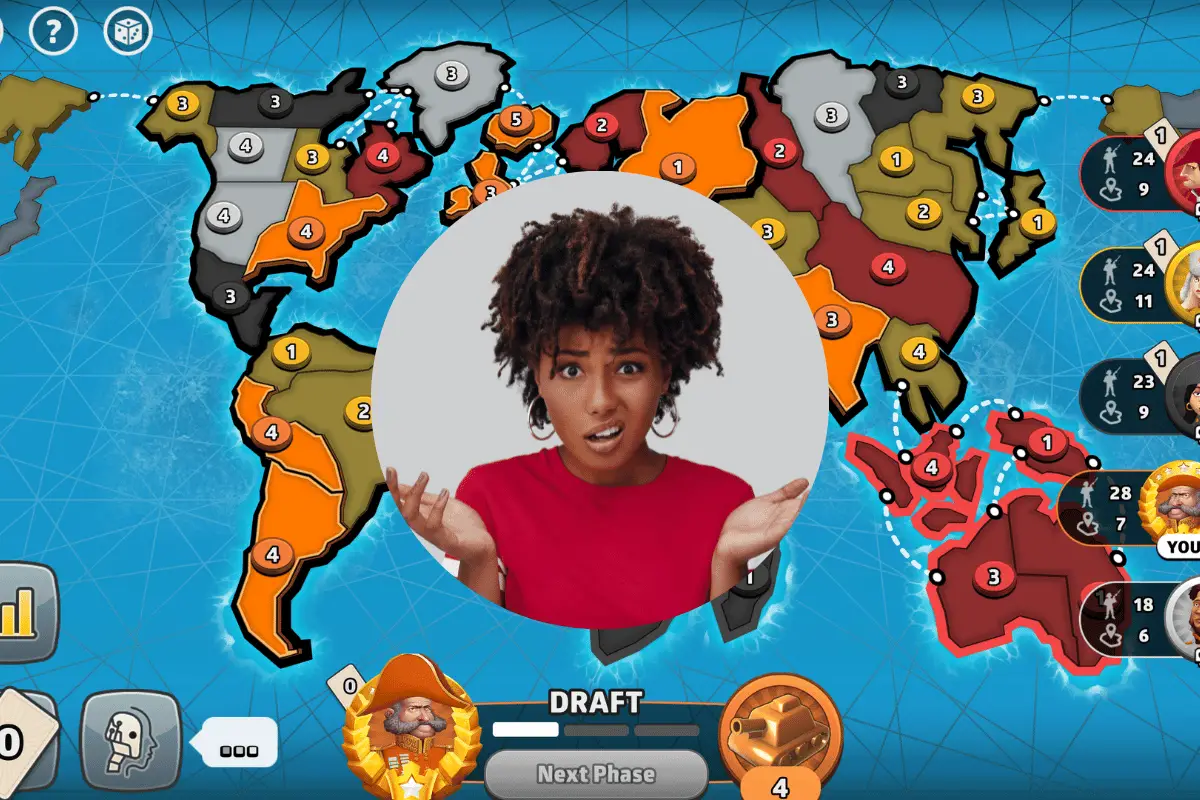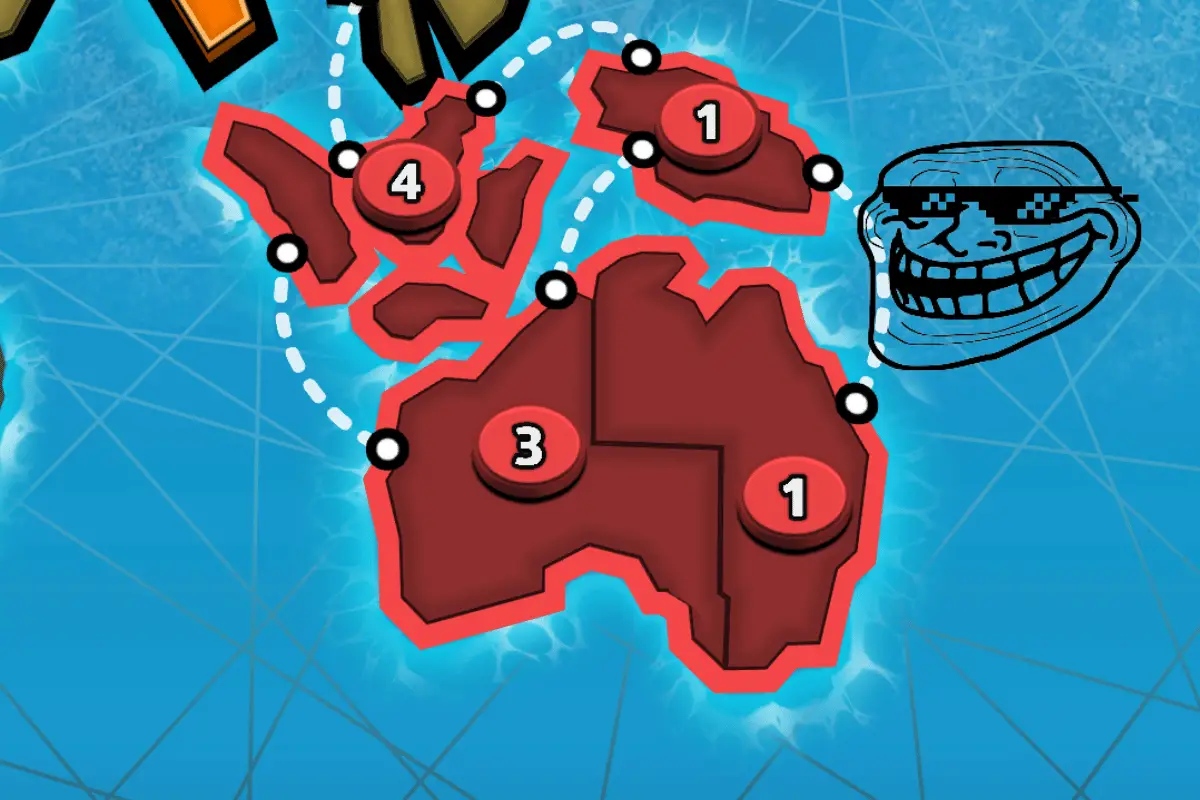RISK, the game of Global Domination, is quite the fun game of strategy, psychology, and luck.
But for those looking at getting into this fun board game, you may be wondering:
Is RISK hard to play?
RISK isn’t hard to play at all. While all the parts look complex, the game is broken into three simple phases. The overall strategy and psychology of the game make this a tough game to master, though.
We’ll look into what makes this game and how to learn it so you can play it right away.

Tired of losing at RISK?
Not sure how to get better?
Check out our list of simple yet powerful RISK Global Domination Strategies to improve your game and winning potential.
Table of Contents
Why Is RISK Hard To Play? (& How To Help)
Setting Up The Game
Setting up the game of RISK is complex for some people who haven’t played before.
There are different phases, methods, and counting you have to do.
And it takes quite a while too!
Basically, setting an over-the-board (OTB) game of RISK involves these essential steps:
- Counting out your troops.
- Determining turn order.
- Placing your troops.
Sounds simple when you boil it down, right?
Let’s take each step one at a time.
Counting Your Troops
Your initial set of troops changes depending on how many players you have. Follow this chart to figure out what you need.
| # of Players | # of Troops at the Beginning |
|---|---|
| 2* | 40 |
| 3 | 35 |
| 4 | 30 |
| 5 | 25 |
| 6 | 20 |
*You’ll also need to set up a third, neutral army with the same amount of troops for two players.
For more information, check out our article on whether or not 2-player RISK is any good.
Determining Turn Order
This one’s an easy one. Each player rolls a die. The highest one goes first.
Reroll if there are ties for first place.
After figuring out who goes first, the play continues to the left.
Placing Your Troops
There are two ways to do this accepted in the official OTB game of RISK.
Place your troops one at a time.
Starting with the player who rolled the highest die, each player puts one army down on an unoccupied territory. This continues until all territories are full.
Then, each player places one army at a time to reinforce. They don’t need to be spread evenly at this point.
This continues until you’ve run out of the troops you counted out in your first step.
Use the territory cards to randomize your position.
Take the deck of territory cards and remove the wild cards. Deal the cards out to each player (in some variations, some players will end up with one less territory.
Place one army on each of the territories in your hand.
Once the world has been filled, begin taking turns to reinforce countries of your choice one at a time.
This makes the beginning process faster and randomizes placement a little more.
Suggestion
I suggest getting the RISK: Global Domination app or digital game from Hasbro to fix this completely.
Start a game with the same number of players and turn AUTO PLACEMENT on.
The game will place all your troops for you. Now, make your board match the game.
This is the fastest way to speed up your setup.
Related Reading: How do you beat Australia in Risk?
Figuring Out How Many Troops You Get Each Turn
The first phase of every turn is reinforcing your armies with a specific number of troops.
For new players, determining the number of troops may be complex.
As with most things in life, let’s break it down into simple terms:
- Troops from your number of territories
- Troops from continent bonuses
- Troops from card bonuses
Troops From Territories
Count how many territories you currently occupy.
Divide the number by three and drop the decimal.
Don’t round up or down. Just drop it.
This is the number of troops you get with a minimum of 3.
So if you only have 5 territories, you still get 3 troops.
Continent Bonuses
If you have all the territories in a specific continent (shown by color), then you get a bonus!
Here’s a quick list of the continents and their bonuses:
- Australia = 2
- South America = 2
- Africa = 3
- North America = 5
- Europe = 5
- Asia = 7
Card Bonuses
Card bonuses are another great way to get more troops and win the game!
There are two modes for bonuses, and you have to decide which you’re playing before the game starts.
You can turn in your cards for a bonus when you hit the following combination of pictures:
- 3 infantry
- 3 calvary
- 3 artillery
- 1 of each
A wild card may be substituted for any one or two cards in these.
Progressive means the number of bonus troops gets higher every time someone turns in a card bonus.
Use a marker or extra card to track the number of territories gained. This is what the numbers around the outside of the RISK board are for.
Progressive games usually end up with a massive amount of troops and are typically over in under 10 rounds.
Fixed card bonus is when you always get the same bonus based on what cards you turn in.
Remember that list from before? This determines how many you get:
- 3 infantry = 4
- 3 calvary = 6
- 3 artillery = 8
- 1 of each = 10
*If you occupy a territory on the card you turn in, you get 2 bonus armies on that territory.
Fortification Rules
Fortification rules come across as quite tricky, and the rules aren’t too clear.
Here’s my answer borrowed from article on the topic:
“During the Fortify phase, you can move as many territories as you want from one territory to any other territory as long as adjacent territories connect them. This means they can move over the entire map as long as they’re connected. You also must leave at least one army in the original territory.”
Read the whole article on fortifying in RISK here.
It’s A Long Game
RISK played as it’s meant to be played OTB can take 2+ hours. It’s a longer game!
How do we speed it up for ourselves?
Here are some tips:
- Use A Dice Roller
- Play for Capitals Or A Faster Game Mode
- Use The Correct Settings When Playing Online
- Play Progressive Bonus, Not Fixed
- Speed Up Setup With Auto Placements
For more details, check out our article on tips on how to speed up the game of RISK.
Commonly Asked Questions
What Is The Easiest Way To Play RISK?
The “easiest” way to play RISK is online. Hasbro has an excellent RISK digital game available for free on all devices.
Can A 7-Year-Old Play RISK?
7-year-olds can play RISK easily. There isn’t any complexity they can’t understand, though they may not win very often as they play impatiently (in my experience). However, don’t expect them to hang around for the whole game in one sitting.







